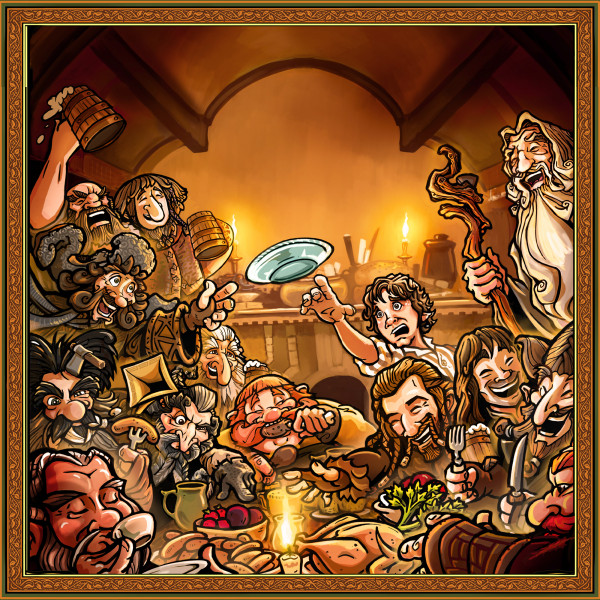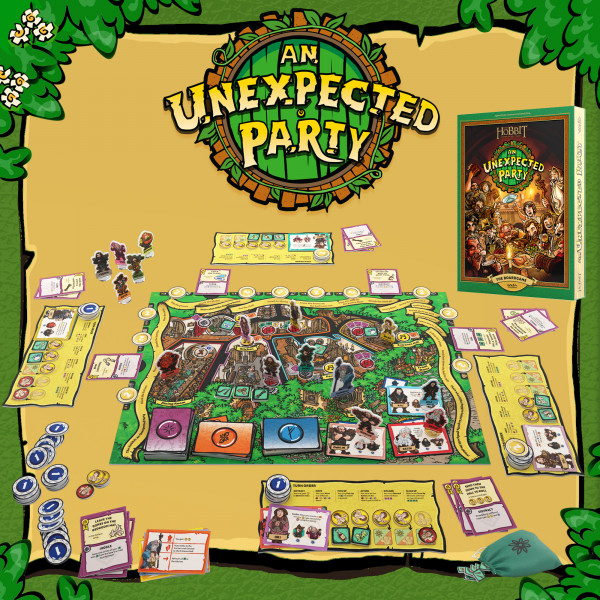

Wētā Workshop unveil new board game: ‘The Hobbit – An Unexpected Party’
Wētā Workshop has unveiled a new board game called The Hobbit – An Unexpected Party.
The game is a fast, fun, action-based tabletop game for 2-4 players, set in the opening scenes of The Hobbit: An Unexpected Journey – when the thirteen Dwarves arrive unannounced at Bag End much to Bilbo’s dismay!
The game features artwork by Wētā Workshop senior concept artist, Daniel Falconer, who also worked on the original The Lord of the Rings and The Hobbit motion picture trilogies.
Daniel Falconer says, "The team at Wētā Workshop wanted to show the lighter side of Tolkien’s world – those humorous, light-hearted moments where you fall in love with the characters just being themselves."
Take a read of his in-depth Q&A on the development process below.

Daniel Falconer – Senior Concept Designer, Wētā Workshop
How did your experience working on The Hobbit and The Lord of the Rings trilogies influence your design for this game?
While working on the films the Wētā Workshop crew and I all got to know The Hobbit characters and world very well. Though fictional, these characters became very real for us. That familiarity meant they were almost like friends to me - and it was fun to think about and hang out with them. During quiet moments I'd sometimes draw cartoon versions of the characters just for kicks. In the back of my mind there was always the thought that perhaps those drawings might eventually become something more, but it wasn't until years later, once Wētā Workshop started developing board games, that the outlet for this became apparent.
My fellow designer Paul Tobin and I sat with Nicola Booth, who at the time was overseeing table-top game development at Wētā Workshop, and we brainstormed ideas for what a possible game based on The Hobbit might look like. There had already been many games of all sorts based on Middle-earth, but almost everyone focussed on the conflict and big, world-changing aspects of the stories that author JRR Tolkien had created. We wanted to do something different: something smaller and lighter in tone, that would be a short game suitable for families to play together. Very quickly we zoned in on the unexpected party that happens at Bilbo's house at the beginning of the story. The many unique Dwarves and the mischief they get up to seemed like a great fit for the tone of game we wanted to make and was one of the more memorable scenes from the first of The Hobbit films. It also lent itself to being interpreted in a cartoony way, which we thought would help give the game a bright, colourful sensibility, rather than something which was illustrated with moody movie stills.

Why did you decide to design this game in the style of Wētā Workshop’s Mini Epics range?
My talented colleague Mauro Santini had already established his own fabulously fun aesthetic interpretation of Middle-earth with the Mini Epics figurines. The design style was already very close to the kind of thing I had been drawing for my own entertainment, so it made sense to pull in behind the Mini Epics brand and embrace the same look for our board game. The Mini Epics were the perfect blend of irreverent humour and stylisation, and as a fan of them, it was a pleasure for me to try to emulate Mauro’s style.
Why the big, bright, bold colours?
Bag End and the Shire are super colourful and cheery, so the game demanded to be colourful! Colour is an important visual tool in a board game because it can be used to call out different characters or elements that have specific and unique functions in a game. The Dwarves were described as each having their own distinct hoods of varying hues in the book, and when designing for the films we leaned into this, giving each Dwarf their own colour palette. On screen it was subtle, but we exaggerated the colour differences and intensity so that the characters would pop visually even in miniature on the game board.
Did you try to capture the unique features of the Dwarves in your illustrations?
When we were designing the Dwarves for the films, Peter Jackson was emphatic about wanting each one to be distinctive. It was important that the audience be able to distinguish them easily, so that led us to lots of extreme beard and hair experimentations, as well as props and costume elements that might suggest specific roles or talents in each individual. Each Dwarf had to be recognisable in silhouette.
Those same needs were equally applicable when it came time to adapt the Dwarves for our game. Because they'd be small on the board, and because caricaturing is a hoot, we emphasized those unique visual elements on each character. Extreme beards or hair became even more extreme, colours were dialled all the way up, and any unique shapes exaggerated.
Dwalin was always the most broad-shouldered Dwarf, so I took that to eleven, making him wider across the shoulders than he was tall; Balin had a long beard, so I grew it to his knees; a little flick on a shoe toe became a big curl, or a tuft of fur a mane, all to make each character both distinctive and funny.

What elements from the actual film set did you include in the design?
Having access to such wonderful reference materials behoved me to use as much of them as I could, so all of the stuff that clutters Bilbo's home in our game board illustration is based on actual set dressing from the films. It was really cool including elements barely visible on screen, like the tree roots of the great oak that grows above Bag End coming down through the hall, the tiny portraits of Bilbo's parents over his parlour fire place, the bird house in his yard, or the distinctive backs of the chairs in his dining room.
What did you enjoy about working on this game?
One thing I really like about the game is that it actually has a moral story. As a parent, I love it when there's a good message for my kids in their entertainment. On face value, it's based on a funny sequence in the movie where the Dwarves tease Bilbo and trash his house, but it's actually something else entirely. Bilbo frets because he thinks they're destroying his stuff, but the Dwarves are actually cleaning up after themselves, albeit in a way that also tickles their mischievous natures. While Bilbo can't see past his worries about his orderly existence being disturbed, in truth the Dwarves are having fun under the watchful eye of Gandalf, who has plotted this whole experience as a learning opportunity for the Hobbit, to shake him out of his homely routine. And underscoring the message of keeping things fun and lighthearted, respecting Bilbo's limits are actually designed into the mechanics of the game: the Dwarves win by keeping Bilbo curious rather than furious.
To see inside Bag End through the eyes of an artist who worked on the films, host your own Unexpected Party.
